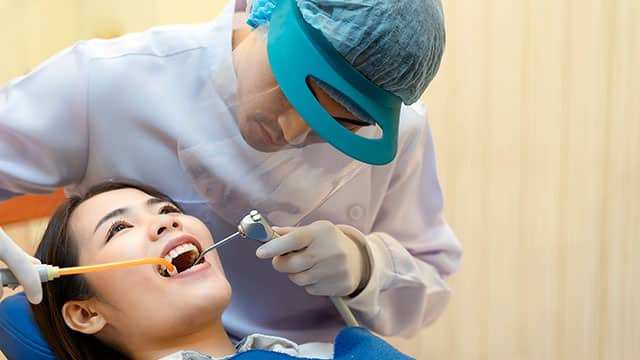Given that the filling is temporary, it requires special care to keep it in place. So let's talk about what a temporary dental filling is as well as why dentists use them. Then, we'll go into what you can eat until a permanent filling is placed. And of course, we'll go over how you can keep up with your daily oral care with the filling in mind.
What is a Temporary Dental Filling?
A temporary filling is a non-permanent structure that's used to restore a damaged tooth. Since these fillings are temporary, they're not meant to last! So, how long does a temporary filling last? Temporary fillings may be needed for several weeks or more. Their role is to stay in place until you see your dentist again to have the temporary filling replaced with a permanent one.
Fillings are generally made up of various materials, like tooth-colored composite resins, porcelain, or dental amalgam. Temporary fillings are much softer and are made up of materials like zinc phosphate cement and glass ionomers.
What Are Temporary Dental Fillings Used For?
Temporary dental fillings are used for several reasons. Here are a few:
- As an emergency cavity treatment. A dentist may place a temporary tooth filling if you have a cavity that causes sharp pain, and your dentist doesn't have time to put in a permanent filling.
- For dental crowns. Your dentist might use a temporary filling if a cavity requires a dental crown. That way, the filling can protect your tooth until the crown is ready.
- As a seal after a root canal. A temporary filling may be used after a root canal to seal a hole in the tooth to prevent bacteria from creating any other dental problems. As it heals, your dentist will replace it with a permanent filling that's right for you.
- As a medicated filling for sensitive nerves. A temporary medicated filling will settle down the nerves in your mouth and allow the tooth to heal before a more permanent filling is placed.
- As a way to work on your teeth across several visits. Since a temporary filling takes less time to place and remove than a permanent filling, this option allows your dentist to do dental work over a few weeks.
Wait To Eat After Your Filling Is Placed
Your dentist will give you specific instructions after your visit about when you can eat. But generally, it's recommended to wait until your anesthesia has worn off, so you don't bite your tongue. For some fillings, you may need to wait for 24 hrs before eating on the side of the mouth with the filling so that the filling stays in place.
Watch What You Chew
Temporary fillings are sensitive. And because they are temporary, they can fall out if you don't take proper care to eat what's suitable for the filling.
Your dentist may tell you to avoid chewing with the side of your mouth that holds the temporary filling. Here are some other eating guidelines to help ease your comfort as well as ensure your filling stays intact:
- Avoid hard foods. Examples include hard candy, ice, and nuts.
- Stay away from sticky foods. This includes gum, toffee, and peanut butter.
- Eat slowly. It'll help you to avoid biting down on the side with your filling.
Always check in with your dentist for other specific recommendations after your temporary filling is placed.
Be Gentle When You Brush and Floss
After you get a temporary filling, you may be wondering how to continue with your daily oral care. Don't worry! It's okay to continue to brush the filled tooth. And to be safe, use a soft or extra-soft bristled toothbrush and brush gently but thoroughly.
Flossing around the newly filled tooth may be tricky. If the filling reaches the edge of your tooth, be extra careful when you floss. Instead of pulling up when you remove the floss from between your teeth, you can pull it out the side to prevent the floss from snagging on the temporary filling and pulling it out.
What If My Temporary Filling Falls Out?
If your filling falls out or feels like it's damaged, contact your dentist right away! Your dentist will be able to fix or replace it. It's essential to communicate with your dentist as soon as you can to avoid any complications.
Now that you know how to care for your temporary dental filling, it should be durable enough to last until your next visit to the dentist. Remember to wait to eat after the filling is placed and follow the dentist's instructions. You'll also want to stay away from sticky and hard foods and be extra mindful when chewing, brushing, and flossing. And if you have any issues with the filling, reach out to your dentist right away! With all of this in place, you're setting yourself up for temporary-dental-filling-success.
Oral Care Center articles are reviewed by an oral health medical professional. This information is for educational purposes only. This content is not intended to be a substitute for professional medical advice, diagnosis or treatment. Always seek the advice of your dentist, physician or other qualified healthcare provider.
ORAL HEALTH QUIZ
What's behind your smile?
Take our Oral Health assessment to get the most from your oral care routine
ORAL HEALTH QUIZ
What's behind your smile?
Take our Oral Health assessment to get the most from your oral care routine















